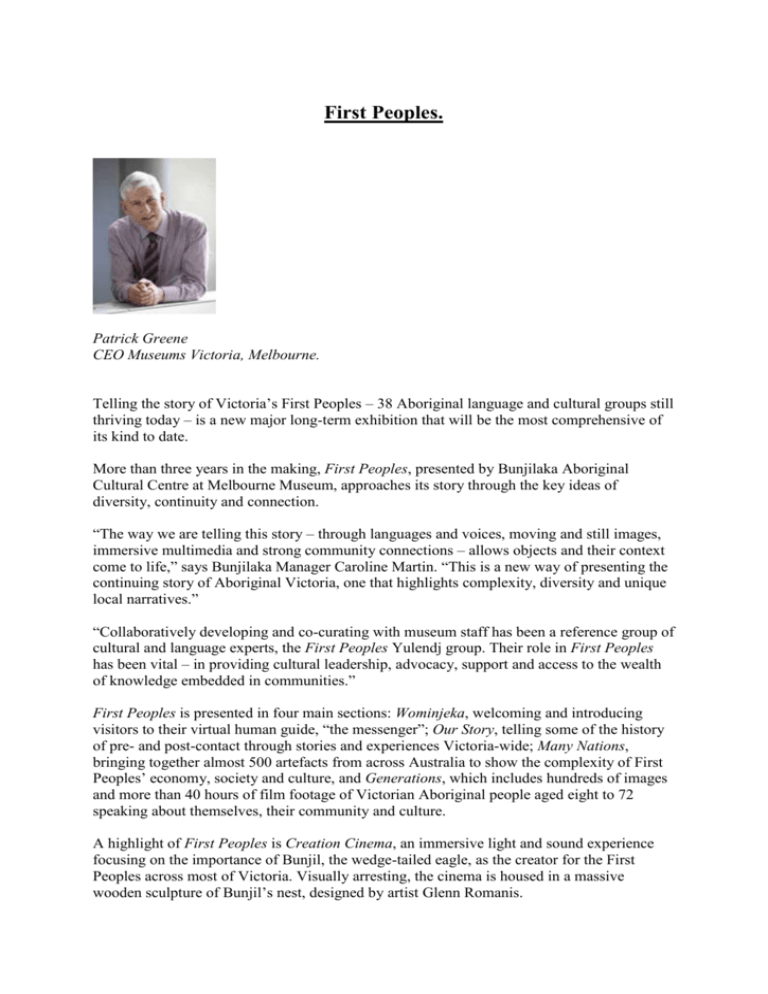First Peoples OK - european museum academy
advertisement

First Peoples. Patrick Greene CEO Museums Victoria, Melbourne. Telling the story of Victoria’s First Peoples – 38 Aboriginal language and cultural groups still thriving today – is a new major long-term exhibition that will be the most comprehensive of its kind to date. More than three years in the making, First Peoples, presented by Bunjilaka Aboriginal Cultural Centre at Melbourne Museum, approaches its story through the key ideas of diversity, continuity and connection. “The way we are telling this story – through languages and voices, moving and still images, immersive multimedia and strong community connections – allows objects and their context come to life,” says Bunjilaka Manager Caroline Martin. “This is a new way of presenting the continuing story of Aboriginal Victoria, one that highlights complexity, diversity and unique local narratives.” “Collaboratively developing and co-curating with museum staff has been a reference group of cultural and language experts, the First Peoples Yulendj group. Their role in First Peoples has been vital – in providing cultural leadership, advocacy, support and access to the wealth of knowledge embedded in communities.” First Peoples is presented in four main sections: Wominjeka, welcoming and introducing visitors to their virtual human guide, “the messenger”; Our Story, telling some of the history of pre- and post-contact through stories and experiences Victoria-wide; Many Nations, bringing together almost 500 artefacts from across Australia to show the complexity of First Peoples’ economy, society and culture, and Generations, which includes hundreds of images and more than 40 hours of film footage of Victorian Aboriginal people aged eight to 72 speaking about themselves, their community and culture. A highlight of First Peoples is Creation Cinema, an immersive light and sound experience focusing on the importance of Bunjil, the wedge-tailed eagle, as the creator for the First Peoples across most of Victoria. Visually arresting, the cinema is housed in a massive wooden sculpture of Bunjil’s nest, designed by artist Glenn Romanis. “The cinema will be a truly beautiful sight outside, and a breathtaking experience inside,” says Martin. “On entering the exhibition, we want visitors to reflect on the deep symbolism and resonance of Bunjil, who represents culture, the law, the land and the people.” Following the cinema is Our Story, which highlights details of how Aboriginal people lived in Victoria before and during European settlement. Among pre-settlement stories is that of mirnong (yam daisy), a staple food collected by women. A 19th-century Boonwurrung digging stick and a basket for collecting and transporting mirnong will be displayed, accompanied by audio of a mirnong song, plant samples and information on how communities are again collecting mirnong along local creeks in Melbourne. The permanent settlements of the Gunditjmara in south-western Victoria and their trading economy around kooyang (“eels” in the Gunditjmara family of languages) are highlighted in a display including a traditional woven eel trap created by elder Eileen Alberts and her daughter Jody-Ann Agnew. “As with all communities we’ve worked alongside in developing First Peoples, the kooyang story is a continuing one,” says Lead Curator, Genevieve Grieves. “Our visitors struggle to understand contemporary Aboriginal identity but there are many examples throughout the exhibition of how cultures have survived and flourish in the contemporary landscape.” Among the exhibition’s unexpected elements is a display of children’s toys in Many Nations that encourages younger visitors to interact in grinding ochre, making music and learning about marngrook (football), through a hands-on activity table. “First Peoples illustrates the complex web of social, cultural and economic ties that operated in south-east Australia before Europeans arrived. Visitors are often surprised when they learn about the complexity of Indigenous cultures, in comparison to stereotypes that are sometimes a barrier to engagement. We are creating a space that is accessible, dynamic and exciting and we want all visitors to feel welcome to come and share in the stories of Victoria’s First Peoples.” “The journey of developing this exhibition has been a profound experience for everyone involved,” says Martin. “While the story we’re telling is at times difficult and tragic, it is ultimately uplifting – how the First Peoples have triumphed over adversity, and how we are still here and continuing to thrive in the 21st century.” The exhibition First Peoples has been announced Overall Winner at the 26th annual American Alliance of Museums (AAM) Excellence in Exhibitions Competition. This international distinction follows awards for Best Exhibition and Best Project nationwide at the Museums and Galleries National Award announced last weekend. Museum Victoria is constantly finding new and interesting ways for visitors of all ages to engage with our collections and exhibitions. We are truly delighted with this national and international recognition for First Peoples – THE destination for everyone to learn about Aboriginal Victoria. First Peoples has just open as a new major long-term exhibition in Bunjilaka Aboriginal Cultural Centre at Melbourne Museum. First Peoples is a shared endeavour of Museum Victoria and the Victorian Aboriginal community. The First Peoples Yulendj Group of Elders and community representatives have brought their knowledge, stories, culture, objects and images to guide the exhibition's development. This is the text of the video which welcome visitors at the beginning of the exhibition: “We walk this land every day Near you, next to you And yet, we are not close You do not know what we know See what we see Feel what we feel But, this can change You can share our culture Hear our stories Know the joy in our hearts The pride The strength With a single word we can connect Wominjeka Welcome.” http://museumvictoria.com.au/bunjilaka/videos/wominjeka/







